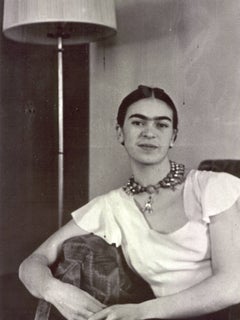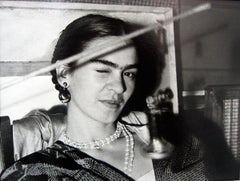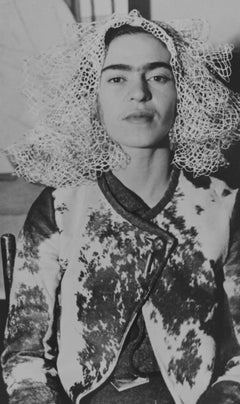Frida Kahlo Lucienne Bloch
20th Century Modern Portrait Photography
Silver Gelatin
20th Century Modern Portrait Photography
Silver Gelatin
Recent Sales
Early 20th Century Modern Black and White Photography
Silver Gelatin
Mid-20th Century Modern Portrait Photography
Silver Gelatin
People Also Browsed
Antique 15th Century and Earlier African Natural Specimens
Bone
Vintage 1950s Italian Mid-Century Modern Chandeliers and Pendants
Brass
1980s Contemporary Abstract Prints
Lithograph, Screen, Woodcut
1930s Surrealist Nude Paintings
Canvas, Oil
Early 1900s Art Nouveau Portrait Prints
Lithograph
21st Century and Contemporary Contemporary Black and White Photography
Film, Photographic Film, Photographic Paper, Black and White, Silver Gel...
1960s Op Art Abstract Prints
Screen
Mid-20th Century Post-War Abstract Paintings
Oil
Vintage 1960s American Mid-Century Modern Cabinets
Brass, Copper, Steel
21st Century and Contemporary Contemporary Landscape Photography
Archival Pigment
20th Century Modern Portrait Photography
Carbon Pigment
1940s Modern Color Photography
Color
Late 19th Century Post-Impressionist Landscape Paintings
Canvas, Oil
Mid-20th Century Modern Portrait Photography
Platinum
20th Century Modern Portrait Photography
Platinum
20th Century Post-Impressionist Figurative Paintings
Canvas, Oil, Panel
Frida Kahlo Lucienne Bloch For Sale on 1stDibs
How Much is a Frida Kahlo Lucienne Bloch?
Lucienne Bloch for sale on 1stDibs
Lucienne Bloch was a prolific artist. Born in Switzerland, she soon moved with her family to America amid the growing tensions of war and anti-Semitism in her native country. At the young age of 15, Bloch attended the Cleveland Institute of Art and later in life enrolled in the École nationale supérieure des beaux-arts in Paris. Excelling in her artistic endeavors, Bloch worked for a number of established artists such as sculptor Antoine Bourdelle and architect Frank Lloyd Wright. However, it was Bloch's encounter with Mexican muralist Diego Rivera and painter Frida Kahlo that solidified her artistic style. Bloch became a close friend of the couple, and later, Bloch was the chief photographer of the Rockefeller Center mural Diego Rivera was working on in New York before it was destroyed. In addition to her photographs, Bloch was a fresco muralist for the Federal Arts Project of the Works Progress Administration from 1934 to 1939. She continued to teach and work until her death in 1999.
(Biography provided by PDNB Gallery)
A Close Look at Modern Art
The first decades of the 20th century were a period of artistic upheaval, with modern art movements including Cubism, Surrealism, Futurism and Dadaism questioning centuries of traditional views of what art should be. Using abstraction, experimental forms and interdisciplinary techniques, painters, sculptors, photographers, printmakers and performance artists all pushed the boundaries of creative expression.
Major exhibitions, like the 1913 Armory Show in New York City — also known as the “International Exhibition of Modern Art,” in which works like the radically angular Nude Descending a Staircase by Marcel Duchamp caused a sensation — challenged the perspective of viewers and critics and heralded the arrival of modern art in the United States. But the movement’s revolutionary spirit took shape in the 19th century.
The Industrial Revolution, which ushered in new technology and cultural conditions across the world, transformed art from something mostly commissioned by the wealthy or the church to work that responded to personal experiences. The Impressionist style emerged in 1860s France with artists like Claude Monet, Paul Cézanne and Edgar Degas quickly painting works that captured moments of light and urban life. Around the same time in England, the Pre-Raphaelites, like Edward Burne-Jones and Dante Gabriel Rossetti, borrowed from late medieval and early Renaissance art to imbue their art with symbolism and modern ideas of beauty.
Emerging from this disruption of the artistic status quo, modern art went further in rejecting conventions and embracing innovation. The bold legacy of leading modern artists Georges Braque, Pablo Picasso, Frida Kahlo, Salvador Dalí, Henri Matisse, Joan Miró, Marc Chagall, Piet Mondrian and many others continues to inform visual culture today.
Find a collection of modern paintings, sculptures, prints and other fine art on 1stDibs.
Finding the Right Black-white-photography for You
There’s a lot to love about black and white photography.
The unique and timeless quality of a black and white photograph accentuates any room. Some might argue that we’re naturally drawn to color photography because it’s the world we know best. This is a shared belief, particularly in the era of camera-phone photography, editing apps and the frenetic immediacy of sharing photos on social media. But when we look at black and white photography, we experience deep, rich shadows and tonal properties in a way that transfixes us. Composition and textures are crisp and engaging. We’re immediately drawn to the subjects of vintage street photography and continue to feel the emotional impact of decades-old photojournalism. The silhouettes of mountains in black and white landscape photography are particularly pronounced, while portrait photography and the skylines of urban cityscapes come to life in monochrome prints.
When decorating with fine photography, keep in mind that some color photographs may not be suitable for every space. However, you can be more daring with black and white photos. The gray tones are classic, sophisticated and generally introduce elegance to any corner of your home, which renders black and white prints amazingly versatile.
Black and white photography adapts to its surroundings like a chameleon might. A single large-scale black and white photograph above the sofa in your living room is going to work with any furniture style, and as some homeowners and designers today are working to introduce more muted tones and neutral palettes to dining rooms and bedrooms, the integration of black and white photography — a hallmark of minimalist decor — is a particularly natural choice for such a setting.
Another advantage to bringing black and white photography into your home is that you can style walls and add depth and character without worrying about disrupting an existing color scheme. Black and white photographs actually harmonize well with accent colors such as yellow, red and green. Your provocative Memphis Group lighting and bold Pierre Paulin seating will pair nicely with the black and white fine nude photography you’ve curated over the years.
Black and white photography also complements a variety of other art. Black and white photos pair well with drawings and etchings in monochromatic hues. They can also form part of specific color schemes. For example, you can place black and white prints in colored picture frames for a pop of color. And while there are no hard and fast rules, it’s best to keep black and white prints separate from color photographs. Color prints stand out in a room more than black and white prints do. Pairing them may detract attention from your black and white photography. Instead, dedicate separate walls or spaces to each.
Once you’ve selected the photography that best fits your space, you’ll need to decide how to hang the images. If you want to hang multiple photos, it’s essential to know how to arrange wall art. A proper arrangement can significantly enhance a living space.
On 1stDibs, explore a vast collection of compelling black and white photography by artists such as Mark Shaw, Jack Mitchell (a photographer you should know), Berenice Abbott and David Yarrow.



